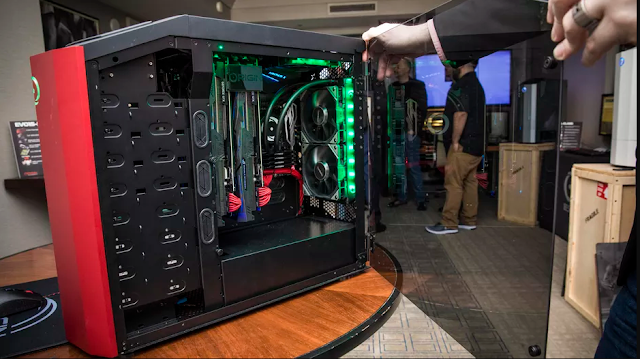At CES 2018, the custom system builder showed off new ways to jazz up its systems as well as updates to the hardware.
Origin PC latest technology is all about the customization, so it's not surprising that the new systems it showed at CES 2018 were mostly (though not entirely) about the razzle dazzle; the company adds first-rate laser etching and textured printing to its Custom Paint options. Of course, there are also some tweaks to system designs, series rejiggering and components.
At the show, Origin PC proudly showed off its latest technology patent award for the four-way motherboard mounting system in the Millennium/Genesis tower PCs; it really is cool, and if you haven't seen it (it's not new), it allows you to insert the motherboard rack in one of four orientations depending on where you want the backplane to sit.
The systems also level up with tempered-glass panels replacing plastic and upgrading some of the plastic to a higher quality reinforced version. The top and doors snap in with magnets, an optional "VR Panel" (really just front connectors) gets a sliding cover and the use of thumbscrews for tool-free card installation. There's also an optional power-supply-unit shroud to match the black, white or red internals. It doesn't light up, but a girl can dream.
Read also
DELL XPS 15 2-IN-1 PACKS POWERFUL INTEL-AMD COMBO AT CES 2018
RUGGED CAT S41 CHARGES DYING PHONES, TAKE PICS UNDERWATER
ONEPLUS CEO: WE'RE GOING TO START TALKING TO US CARRIERS
Behold Origin PC's latest technology flashy laser-etched computers
Origin broke the Genesis Pro line -- the Millennium plus a base that holds extra cooling or up to 24 hard drives -- into its own workstation-level L-Class, partly to make it easier to find and configure systems optimized for specific software (such as Adobe Creative Cloud and Autodesk Maya).
Its Omni all-in-one gaming desktop gets a sleeker chassis and a 144Hz Samsung IPS display -- still a 34-inch 1440p -- and its redesigned base is more stable. It uses a smaller motherboard and has a lot more space inside for airflow. The company's working on a clear panel for it (yay!), but the connectors are still inconveniently situated.
Finally, its Chronos compact desktop will be getting a slightly less compact sibling to accommodate dual GPUs, a bigger power supply and overclockability.
Origin PC latest technology is all about the customization, so it's not surprising that the new systems it showed at CES 2018 were mostly (though not entirely) about the razzle dazzle; the company adds first-rate laser etching and textured printing to its Custom Paint options. Of course, there are also some tweaks to system designs, series rejiggering and components.
At the show, Origin PC proudly showed off its latest technology patent award for the four-way motherboard mounting system in the Millennium/Genesis tower PCs; it really is cool, and if you haven't seen it (it's not new), it allows you to insert the motherboard rack in one of four orientations depending on where you want the backplane to sit.
The systems also level up with tempered-glass panels replacing plastic and upgrading some of the plastic to a higher quality reinforced version. The top and doors snap in with magnets, an optional "VR Panel" (really just front connectors) gets a sliding cover and the use of thumbscrews for tool-free card installation. There's also an optional power-supply-unit shroud to match the black, white or red internals. It doesn't light up, but a girl can dream.
Read also
DELL XPS 15 2-IN-1 PACKS POWERFUL INTEL-AMD COMBO AT CES 2018
RUGGED CAT S41 CHARGES DYING PHONES, TAKE PICS UNDERWATER
ONEPLUS CEO: WE'RE GOING TO START TALKING TO US CARRIERS
Behold Origin PC's latest technology flashy laser-etched computers
Origin broke the Genesis Pro line -- the Millennium plus a base that holds extra cooling or up to 24 hard drives -- into its own workstation-level L-Class, partly to make it easier to find and configure systems optimized for specific software (such as Adobe Creative Cloud and Autodesk Maya).
Its Omni all-in-one gaming desktop gets a sleeker chassis and a 144Hz Samsung IPS display -- still a 34-inch 1440p -- and its redesigned base is more stable. It uses a smaller motherboard and has a lot more space inside for airflow. The company's working on a clear panel for it (yay!), but the connectors are still inconveniently situated.
Finally, its Chronos compact desktop will be getting a slightly less compact sibling to accommodate dual GPUs, a bigger power supply and overclockability.



Comments
Post a Comment
leave a comment